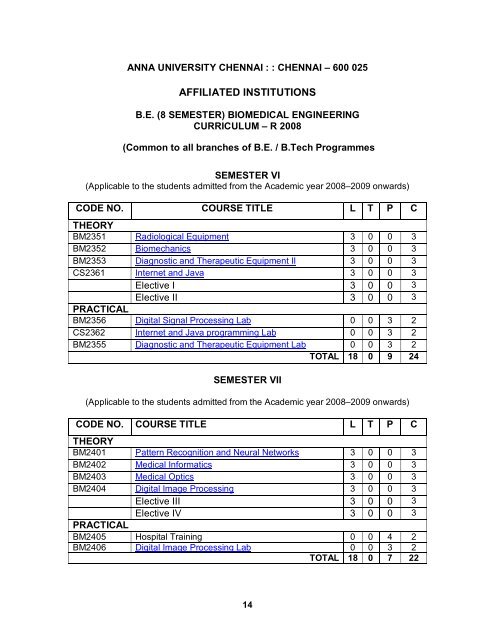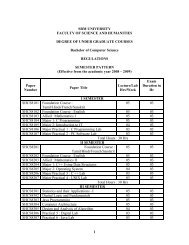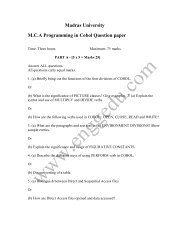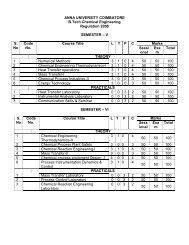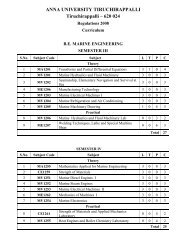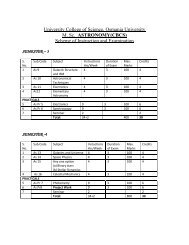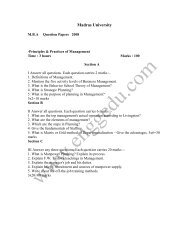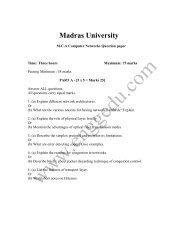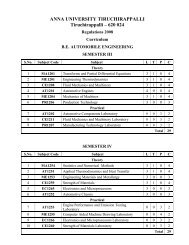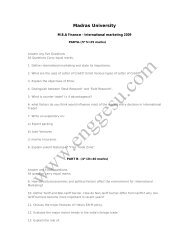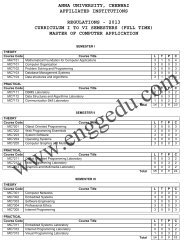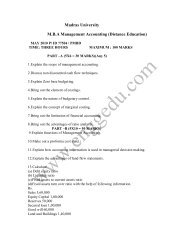AFFILIATED INSTITUTIONS - Engineering and Higher Education ...
AFFILIATED INSTITUTIONS - Engineering and Higher Education ...
AFFILIATED INSTITUTIONS - Engineering and Higher Education ...
You also want an ePaper? Increase the reach of your titles
YUMPU automatically turns print PDFs into web optimized ePapers that Google loves.
SEMESTER VIII(Applicable to the students admitted from the Academic year 2008–2009 onwards)CODE NO. COURSE TITLE L T P CTHEORYElective IV 3 0 0 3Elective V 3 0 0 3PRACTICALBM2451 Project Work 0 0 12 6TOTAL 6 0 12 12LIST OF ELECTIVESSEMESTER VI – Elective ICODE NO. COURSE TITLE L T P CBM2021 Bio Fluids <strong>and</strong> Dynamics 3 0 0 3BM2022 Biometric Systems 3 0 0 3EC2303 Computer Architecture <strong>and</strong> Organization 3 0 0 3SEMESTER VI – Elective IICODE NO. COURSE TITLE L T P CCS2068 Data Structures <strong>and</strong> Object Oriented Programming 3 0 0 3GE2071 Intellectual Property Rights 3 0 0 3GE2072 Indian Constitution <strong>and</strong> Society 3 0 0 3SEMESTER VII - Elective IIICODE NO. COURSE TITLE L T P CBM2023 Physiological Modeling 3 0 0 3BM2024 Bio Informatics 3 0 0 3GE2022 Total Quality Management 3 0 0 3EC2038 Nano Electronics 3 0 0 315
SEMESTER VII - Elective IVCODE NO. COURSE TITLE L T P CEC2352 Computer Networks 3 0 0 3CS2069 Computer Hardware, Interfacing <strong>and</strong>3 0 0 3InstrumentationBM2027 Refrigeration <strong>and</strong> Air-Conditioning 3 0 0 3SEMESTER VIII - Elective VCODE NO. COURSE TITLE L T P CBM2029 Bio MEMS 3 0 0 3BM2025 Assist Devices 3 0 0 3EC2354 VLSI Design 3 0 0 3GE2021 Professional Ethics in <strong>Engineering</strong> 3 0 0 3SEMESTER VIII - Elective VICODE NO. COURSE TITLE L T P CBM2026 Medical Imaging Techniques 3 0 0 3CS2053 Soft Computing 3 0 0 3BM2028 Rapid Prototyping 3 0 0 316
BM2351 RADIOLOGICAL EQUIPMENT L T P C3 0 0 3AIMTo get the clear underst<strong>and</strong>ing of X-ray generation <strong>and</strong> radio isotopes <strong>and</strong> varioustechniques used for visualizing organs in detail.OBJECTIVESTo study the functioning of X-ray tubes <strong>and</strong> scattered radiation <strong>and</strong> method by whichfogginess can be reduced.To study the different types radio diagnostic unit.To know the techniques to visualize opaque, transparent organs.To study the special techniques adopted to visualize different sections of any organ.UNIT I MEDICAL X-RAY EQUIPMENT 9Nature of X-Rays - X-ray Absorption - Tissue Contrast. X-Ray Equipment (BlockDiagram) – X-ray Tube, the collimator, Bucky Grid, power supply. Digital Radiography -discrete digital detectors, storage phosphor <strong>and</strong> film Scanning. X-Ray Image intensifiertubes - Fluoroscopy – Digital Fluoroscopy. Angiography, Cine angiography. DigitalSubtraction Angiography. Mammography.UNIT II COMPUTER TOMOGRAPHY 9Principles of Tomography - First to Fourth generation scanners – Image reconstructiontechnique- Back projection <strong>and</strong> Iterative method. Spiral CT Scanning - Ultra fast CTScanners- X-Ray Sources – Collimation – X-Ray Detectors – Viewing System.UNIT III MAGNETIC RESONANCE IMAGING 9Fundamentals of Magnetic Resonance- Interaction of nuclei with static Magnetic Field<strong>and</strong> Radio frequency wave – Rotation <strong>and</strong> Precession –induction of a magneticresonance signal – bulk Magnetization – Relaxation Processes T1 <strong>and</strong> T2. Blockdiagram approach of MRI system- System Magnet (Permanent, Electromagnet <strong>and</strong>super conductors) , generation of Gradient magnetic Fields , Radio Frequency coils(sending <strong>and</strong> receiving) Shim coils, Electronic components.UNIT IV NUCLEAR MEDICINE SYSTEMS 9Radio isotopes- alpha, beta <strong>and</strong> gamma radiations. Radio pharmaceuticals.Radiationdetectors - Gas Filled, ionization Chambers, proportional counter, GM counter <strong>and</strong>Scintillation Detectors. Gamma Camera- Principle of operation, Collimator, Photomultiplier tube, X-Y Positioning Circuit, Pulse height Analyzer. Principles of SPECT<strong>and</strong> PET.UNIT V RADIATION THERAPY AND RADIATION SAFETY 9Radiation therapy-Linear accelerator, betatron, cesium <strong>and</strong> cobalt .Radiation Protectionin Medicine –Radiation Protection principles, Radiation measuring instruments-Dosimeter, film Badges, Thermo luminescent dosimeters – Electronic dosimeter- ICRPregulation Practical reduction of dose to staff <strong>and</strong> visitors.TOTAL = 45 PERIODSTEXT BOOKS1. Steve webb, Physics of Medical Imaging, , Taylor <strong>and</strong> Francis, 1988.2. R. Hendee <strong>and</strong> Russell Ritenour “Medical Imaging Physics”–William,Wiley, FourthEdition 2002.17
REFERENCE BOOKS1. Physics <strong>and</strong> Radiobiology of Nuclear Medicine –Third edition – Gopal B.Saha –Publisher – Springer, 2006.2. Medical Physics <strong>and</strong> Biomedical <strong>Engineering</strong> –B.H Brown , PV Lawford, R H Smallwood , D R Hose , D C Barber , CRC Press, 1999.3. St<strong>and</strong>ard h<strong>and</strong>book of Biomedical <strong>Engineering</strong> <strong>and</strong> Design – Myer Kutz Publisher –McGraw – Hill, 2003.4. P.Raghunathan, “Magnetic Resonance Imaging <strong>and</strong> Spectroscopy in Medicine”Concepts <strong>and</strong> Techniques, Orient Longman, 2007.BM 2352 BIOMECHANICS L T P C3 0 0 3UNIT I INTRODUCTION 9Scope of mechanics in medicine, mechanics of bone structure, determination of in-vivoelastic modulus. Biofluid mechanics, flow properties of blood.UNIT II MECHANICS OF PHYSIOLOGICAL SYSTEMS 9Heart valves, power developed by the heart, prosthetic valves. Constitutive equationsfor soft tissues, dynamics of fluid flow in cardiovascular system <strong>and</strong> effect of vibration -shear stresses in extra-corporal circuits.UNIT III ORTHOPAEDIC MECHANICS 9Mechanical properties of cartilage, diffusion properties of articular cartilage, mechanicalproperties of bone, kinetics <strong>and</strong> kinematics of joints, Lubrication of joints.UNIT IV MATHEMATICAL MODELS 9Introduction to Finite Element Analysis, Mathematical models - pulse wave velocities inarteries, determination of in-vivo elasticity of blood vessel, dynamics of fluid filledcatheters.UNIT V ORTHOPAEDIC APPLICATIONS 9Dynamics <strong>and</strong> analysis of human locomotion - Gait analysis (determination ofinstantaneous joint reaction analysis), occupant response to vehicular vibration.Mechanics of knee joint during st<strong>and</strong>ing <strong>and</strong> walking.TOTAL: 45 PERIODSTEXT BOOKS:1. Dhanjoo N. Ghista, “Bio-mechanics of Medical Devices”, Marcel Dekker, 1980.2. Haufred Clynes, “Bio-medical <strong>Engineering</strong> Systems”, McGraw Hill, 1998.REFERENCES1. Y.C. Fung, “Bio-Mechanics- Mechanical Properties of Tissues”, Springer-Verlag,1998.2. Dhanjoo N. Ghista, “Orthopaedic Mechanics”, Academic Press, 1990.18
BM2353 DIAGNOSTIC AND THERAPEUTIC EQUIPMENTS-II L T P C3 0 0 3UNIT I ULTRASONIC TECHNIQUE 9Diagnosis: Basic principles of Echo technique, display techniques A, B <strong>and</strong> M mode,Application of ultrasound as diagnostic tool – Echocardiogram, abdomen, obstetrics <strong>and</strong>gynaecology, ophthalmology.UNIT II PATIENT MONITORING AND BIOTELEMETRY 9ICU/CCU Equipments, Infusion pumps, bed side monitors, Central consoling controls.Radio Telemetry (single, multi), Portable <strong>and</strong> L<strong>and</strong>line Telemetry unit, Applications inECG <strong>and</strong> EEG Transmission.UNIT III DIATHERMY 9IR <strong>and</strong> UV lamp <strong>and</strong> its application. Thermography – Recording <strong>and</strong> clinical application.Short wave diathermy, ultrasonic diathermy, Microwave diathermy, Electro surgerymachine - Current waveforms, Tissue Responses, Electro surgical current level.UNIT IV EXTRA CORPOREAL DEVICES ANDSPECIAL DIAGNOSTIC TECHNIQUES 9Need for heart lung machine, functioning of bubble, disc type <strong>and</strong> membrane typeoxygenerators, finger pump, roller pump, electronic monitoring of functional parameter.Haemo Dialyser unit , Lithotripsy, Principles of Cryogenic technique <strong>and</strong> application,Endoscopy, Laproscopy.UNIT V PATIENT SAFETY 9Physiological effects of electricity – important susceptibility parameters – Macro shock –Micro shock hazards – Patient’s electrical environment – Isolated Power system –Conductive surfaces – Electrical safety codes <strong>and</strong> st<strong>and</strong>ards – Basic Approaches toprotection against shock, Protection equipment design, Electrical safety analyzer –Testing the Electric systemTOTAL: 45 PERIODSTEXT BOOK1. Leslie Cromwell, “Biomedical Instrumentation <strong>and</strong> Measurement”, Prentice Hall ofIndia, New Delhi, 20072. John G. Webster, “Medical Instrumentation Application <strong>and</strong> Design”, John Willey <strong>and</strong>sons, 20023. Joseph J. Carr <strong>and</strong> John M. Brown, “Introduction to Biomedical equipmenttechnology”, John Willey <strong>and</strong> sons, New York, 1997REFERENCE BOOKS1. Principles of Biomedical Instrumentation <strong>and</strong> Measurement” – Richard Aston, MerrilPublishing Company, 1990.2. Principles of Applied Biomedical Instrumentation L.A Geddas <strong>and</strong> L.E.Baker – 2004.3. John G. Webster, Bioinstrumentation”, John Willey <strong>and</strong> sons, New York, 2004.4. Kh<strong>and</strong>pur R.S, “H<strong>and</strong>book of Biomedical Instrumentation”, Tata McGraw- Hill, NewDelhi, 2003.5. St<strong>and</strong>ard H<strong>and</strong>book of Biomedical <strong>Engineering</strong> & Design – Myer Kutz6. McGraw-Hill Publisher, 2003.19
CS2361 INTERNET AND JAVA L T P C3 0 0 3UNIT I WORLD WIDE WEB 9HTTP protocol, Web browsers Netscape, Internet explorer, Web site <strong>and</strong> web pagedesign,XHTML, Dynamic HTML, CSS.UNIT II JAVASCRIPT PROGRAMMING 9Introduction, Control statements, Functions, Arrays <strong>and</strong> Objects.UNIT III 9Micromedia Dream Weaver, XML, Web Servers, Databases – SQL, MYSQL, DBI <strong>and</strong>ADO.NETUNIT IV JAVA PROGRAMMING 9Language features, Classes, Object <strong>and</strong> methods. Sub-classing <strong>and</strong> dynamic binding,Multithreading, Overview of class library, Object method serialization, Remote methodinvocation, Java Servelets <strong>and</strong> Javaserver pages.UNIT V WEB DESIGN AND MEDICAL STANDARDS 9Web Design case studies – Design <strong>and</strong> development of Dynamic Hospital InformationSystem Web sites using Macromedia Dreamweaver, Java, XML, Javascript,Programming Techniques. HL7 St<strong>and</strong>ards, DICOM st<strong>and</strong>ards.TOTAL=45 PERIODSTEXT BOOKS:1. Deitel, Internet <strong>and</strong> World Wide Web, Pearson <strong>Education</strong> / PHI, 20072. Deitel, “Java How to Program”, Pearson <strong>Education</strong> / PHI, 2006.3. Herbert Schildt, The complete Reference JAVA 2, Fifth Edition, Tata McGRaw HillPublishing Com.Ltd, New Delhi.4. Achyut S Godbole <strong>and</strong> Atul Kahate, Web Technologies, TCP / IP to InternetApplication Architecture, TMH, 2007.REFERENCES:1. Margaret Levine Young, “Internet The Complete Reference”, Tata McGraw Hill,1999.2. Cay S. Horstmann & Gary Cornell, Core Java tm Volume – I & II, Pearson <strong>Education</strong>,2006.3. Balagurusamy.E.`Programming with Java, A premier` Second Edition, Tata McGrawHill,2006BM2356 DIGITAL SIGNAL PROCESSING LAB L T P C0 0 3 2MATLAB / Equivalent Software Package(30% of the course)1. Generation of sequences (functional & r<strong>and</strong>om), correlation <strong>and</strong> convolution2. Spectrum Analysis using FFT3. Filter Design & Analysis4. Filter Implementation in time-domain & frequency domain5. Study of Quantization errors in DSP algorithms6. Multirate Filters7. Adaptive filter8. Equalization9. Echo Cancellation20
Study of shortwave <strong>and</strong> ultrasonic diathermy.Study of biotelemetryElectrical safety measurements.Mini project.TOTAL=45 PERIODSBM2401 PATTERN RECOGNITION AND NEURAL NETWORKS L T P C3 0 0 3UNIT I INTRODUCTION AND SIMPLE NEURAL NET 9Elementary neurophysiology <strong>and</strong> biological neural network-Artificial neural network –Architecture, biases <strong>and</strong> thresholds, Hebb net, Perceptron, Adaline <strong>and</strong> Madaline.UNIT II BACK PROPOGATION AND ASSOCIATIVE MEMORY 9Back propogation network, generalized delta rule, Bidirectional Associative memory,Hopefield networkUNIT III NEURAL NETWORKS BASED ON COMPETITION 9Kohonen Self organising map, Learning Vector Quantisation, counter propogationnetwork.UNIT IV UNSUPERVISED LEARNING AND CLUSTERING ANALYSIS 9Patterns <strong>and</strong> features, training <strong>and</strong> learning in pattern recognition, discriminant functions,different types of pattern recognition. Unsupervised learning- hierarchical clustering,partitional clustering. Neural pattern recognition approach – perceptron modelUNIT V SUPERVISED LEARNING USING PARAMETRIC ANDNON PARAMETRIC APPROACH 9Bayesian classifier, non parametric density estimation, histograms, kernels, windowestimators, k-nearest neighbour classifier , estimation of error rates.TOTAL: 45 PERIODSTEXT BOOKS:1. Hagan, Demuth <strong>and</strong> Beale, “Neural network design”, Vikas Publishing2. House Pvt. Ltd., New Delhi , 20023. Freeman J.A., <strong>and</strong> Skapura B.M, " Neural networks, algorithms, applications <strong>and</strong>programming techniques”, Addison – Wesley,20034. Duda R.O, Hart P.G, “Pattern classification <strong>and</strong> scene analysis”, Wiley Edition,20005. Earl Gose, Richard Johnsonbaugh, Steve Jost, “Pattern Recognition <strong>and</strong> ImageAnalysis”, Prentice Hall of India Pvt. Ltd., New Delhi, 1999.REFERENCES:1. Robert Schalkoff, “ Pattern recognition, Statistical, Structural <strong>and</strong> neural approaches”John Wiley <strong>and</strong> Sons(Asia) Pte. Ltd., Singapore, 20052. Laurene Fausett ,” Fundamentals of neural networks – Architectures, algorithms <strong>and</strong>applications”, Prentice Hall, 1994.22
BM2402 MEDICAL INFORMATICS L T P C3 0 0 3UNIT I MEDICAL INFORMATICS 9Introduction - Structure of Medical Informatics –Internet <strong>and</strong> Medicine -Security issues ,Computer based medical information retrieval, Hospital management <strong>and</strong> informationsystem, Functional capabilities of a computerized HIS, e-health services, HealthInformatics – Medical Informatics, BioinformaticsUNIT II COMPUTERISED PATIENT RECORD 9Introduction - History taking by computer, Dialogue with the computer, Components <strong>and</strong>functionality of CPR, Development tools, Intranet, CPR in Radiology- Application serverprovider, Clinical information system, Computerized prescriptions for patients.UNIT III COMPUTERS IN CLINICAL LABORATORYAND MEDICAL IMAGING 9Automated clinical laboratories-Automated methods in hematology, cytology <strong>and</strong>histology, Intelligent Laboratory Information System - Computerized ECG, EEG <strong>and</strong>EMG, Computer assisted medical imaging- nuclear medicine, ultrasound imagingultrasonography-computed X-ray tomography, Radiation therapy <strong>and</strong> planning,Nuclear Magnetic ResonanceUNIT IV COMPUTER ASSISTED MEDICAL DECISION-MAKING 9Neuro computers <strong>and</strong> Artificial Neural Networks application, Expert system - Generalmodel of CMD, Computer –assisted decision support system-production rule systemcognitivemodel, semester networks , decisions analysis in clinical medicine-computersin the care of critically patients-computer assisted surgery-designingUNIT V RECENT TRENDS IN MEDICAL INFORMATICS 9Virtual reality applications in medicine, Computer assisted surgery , Surgical simulation ,Telemedicine - Tele surgery computer aids for the h<strong>and</strong>icapped, computer assistedinstrumentation in Medical Informatics - Computer assisted patient education <strong>and</strong> health- Medical education <strong>and</strong> health care information.TOTAL: 45 PERIODSTEXT BOOKS:1. 1.R.D.Lele Computers in medicine progress in medical informatics, Tata Mcgraw HillPublishing computers Ltd,2005, New Delhi.2. Mohan Bansal, Medicl informatics Tata Mcgraw Hill Publishing computers Ltd,2003 New Delhi.BM2403 MEDICAL OPTICS L T P C3 0 0 3UNIT I OPTICAL PROPERTIES OF THE TISSUES 9Refraction, Scattering, absorption, light transport inside the tissue, tissue properties,Light interaction with tissues, optothermal interaction, fluorescence, speckles.UNIT II INSTRUMENTATION IN PHOTONICS 9Instrumentation for absorption, scattering <strong>and</strong> emission measurements, excitation lightsources – high pressure arc lamp, solid state LEDs, Lasers, optical filters, polarizer, solidstate detectors, time resolved <strong>and</strong> phase resolved detectors.23
UNIT III APPLICATIONS OF LASERS 9Laser in tissue welding, lasers in dermatology, lasers in ophthalmology, otolaryngology,urology.UNIT IV OPTICAL TOMOGRAPHY 9Optical coherence tomography, Elastrography, Doppler optical coherence tomography,Application towards clinical imaging.UNIT V SPECIAL OPTICAL TECHNIQUES 9Near field imaging of biological structures, in vitro clinical diagnostic, fluorescentspectroscopy, photodynamic therapy.TOTAL: 45 PERIODSTEXT BOOKS:1. Tuan Vo Dirh, “Biomedical photonics – H<strong>and</strong>book”, CRC Press, Bocaraton, 2003.2. Mark E. Brezinski., Optical Coherence Tomography: Principles <strong>and</strong>Applications,Academic Press, 2006.REFERENCES:1. Leon Goldman, M.D., & R. James Rockwell, Jr., “Lasers in Medicine”, Gordon <strong>and</strong>Breach, Science Publishers Inc., New York, 1971.2. R. Splinter <strong>and</strong> B.A Hooper, An Introduction to BioMedical Optics,Taylor <strong>and</strong>Francis,2007.BM2404 DIGITAL IMAGE PROCESSING L T P C3 0 0 3AIMTo study the image processing techniquesOBJECTIVES To study the image fundamentals <strong>and</strong> image transforms To study the image enhancement techniques To study the image restoration procedures To study the image compression proceduresUNIT I DIGITAL IMAGE FUNDAMENTAL 9Elements of digital image processing systems - Elements of visual perception – imagesampling <strong>and</strong> quantization – basic relationships between pixels - matrix <strong>and</strong> singularvalue representation of discrete images.UNIT II IMAGE TRANSFORMS 91-D DFT - 2-D DFT – DCT – DST – Walsh - Hadamard – Haar – Slant – KL – SVD <strong>and</strong>their properties.UNIT III IMAGE ENHANCEMENT 9Gray level transformation – Histogram processing – enhancement using arithmetic/logicoperation – spatial filtering – smoothening <strong>and</strong> sharpening spatial filter – smoothening infrequency domain filter – homomorphic filteringUNIT IV IMAGE RESTORATION AND RECOGNITION 9Image degradation models – unconstrained <strong>and</strong> constrained restoration – inversefiltering – LMS filter – geometric mean filter – geometric transformation – pattern classes– optimal statistical classifier – neural networks <strong>and</strong> its uses in image processing.24
UNIT V IMAGE COMPRESSION 9Image compression models – elements of information theory – error free compression –lossy compression – run-length – Huffman coding – shift codes – arithmetic coding – bitplane coding – transform coding – JPEG st<strong>and</strong>ards – MPEG st<strong>and</strong>ards - wavelettransform – predictive techniques – block truncation coding schemes – facet modeling.Image segmentation – detection of discontinuities – edge linking <strong>and</strong> boundary detection– thresholding – region based segmentation – segmentation by morphologicalwatersheds – use of motion in segmentation.TOTAL: 45 PERIODSTEXT BOOK:1. Rafel C. Gonzalez <strong>and</strong> Richard E. Woods, “Digital Image Processing" Pearsoneducation, 2007.2. Anil K. Jain, “Fundamentals of Digital Image Processing”, PHI, 1997REFERENCES:1. Willian K. Pratt, “Digital Image Processing”, John Wiley, NJ, 1987.2. Sid Ahmed M. A., “Image Processing Theory, Algorithm <strong>and</strong> Architectures”, McGrawHill, 19953. Scott E. C. Umbaugh, “Computer Vision <strong>and</strong> Image Processing”, Prentice Hall,Eaglewood Cliffs, NJ, 1998.BM2406 DIGITAL IMAGE PROCESSING LAB L T P C0 0 3 21. Display of Grayscale Images.2. Histogram Equalization.3. Non-linear Filtering.4. Edge detection using Operators.5. 2-D DFT <strong>and</strong> DCT.6. Filtering in frequency domain.7. Display of color images.8. conversion between color spaces.9. DWT of images.10. Segmentation using watershed transform.TOTAL:45 PERIODSREFERENCE:1. Rafael C. Gonzalez, Richard E. Woods, Steven Eddins,' Digital Image Processingusing MATLAB', Pearson <strong>Education</strong>, Inc., 2004.LIST OF EQUIPMENTS:Computer, Software MATLAB25
BM2021 BIOFLUIDS AND DYNAMICS L T P C3 0 0 3UNIT I 10BIO-FLUID MECHANICS: Newton’s laws, Stress, Strain, Elasticity, Hooks-law, viscosity,Newtonian fluid, Non-Newtonian fluid, Viscoelastic fluids, vascular tree, Relationshipbetween diameter, velocity <strong>and</strong> pressure of blood flow, Resistance against flow.BIOVISCOELASTIC FLUID: Viscoelasticity - Viscoelastic models, Maxwell, Voigt <strong>and</strong>Kelvin Models, Response to Harmonic variation, Use of viscoelastic models, Bio-Viscoelastic fluids: Protoplasm, Mucus, Saliva, Synovial fluids.UNIT II 10FLOW PROPERTIES OF BLOOD: Physical, Chemical <strong>and</strong> Rheological properties ofblood. Apparent <strong>and</strong> relative viscosity, Blood viscosity variation: Effect of shear rate,hematocrit, temperature, protein contents of blood. Casson’s equation, Problemsassociated with extracorporeal blood flow. RHEOLOGY OF BLOOD INMICROVESSELS: Fahraeus -Lindquist effect <strong>and</strong> inverse effect, distribution ofsuspended particles in a narrow rigid tube. Nature of red blood cells in tightly fittingtubes, hematocrit in very narrow tube.UNIT III 9CARDIAC MECHANICS: Cardiovascular system. Mechanical properties of bloodvessels: arteries, arterioles, capillaries <strong>and</strong> veins. Blood flow: Laminar <strong>and</strong>Turbulent, Physics of cardiovascular diseases, Prosthetic heart valves <strong>and</strong>replacements. RESPIRATORY MECHANICS: Alveoli mechanics, Interaction of Blood<strong>and</strong> Lung P-V curve of Lung: Breathing mechanism, Airway resistance, Physics of Lungdiseases.UNITIV 8SOFT TISSUE MECHANICS: Pseudo elasticity, non-linear stress-strain relationship,Viscoelasticity, Structure, function <strong>and</strong> mechanical properties of skin, ligaments <strong>and</strong>tendons.UNIT V 8ORTHOPEDIC MECHANICS: Mechanical properties of cartilage, diffusion properties ofArticular cartilage, mechanical properties of bone, kinetics <strong>and</strong> kinematics of joints,lubrication of joints.TOTAL: 45 PERIODSTEXT BOOKS:1. Y.C Fung, Biomechanics- Mechanical properties of living tissues,2nd ed, Springer-Verlag, 1993.2. D.O Cooney, Biomedical engineering Principles. Marcel Dekker, INC NewYork.1976.REFERENCES:1. Silver Frederick H. Biomaterials, Medical Devices & Tissue <strong>Engineering</strong>: Chapman &Hall, London, 19942. Biomechanics by Nihanth ozkai,3. D.A Mc Donald, Blood flow in arteries, Edward Arnold ltd, 1998.26
BM 2022 BIOMETRIC SYSTEMS L T P C3 0 0 3UNIT I BIOMETRIC FUNDAMENTALS 9Key Biometric terms <strong>and</strong> Processes – Definitions-verification <strong>and</strong> identification –matching, Accuracy in Biometric Systems – False match rate - False nonmatch rate -Failure to enroll rate – Derived metrics - An Introduction to Biometric AuthenticationSystems- a taxonomy of application environment, a system model, biometrics <strong>and</strong>privacy.UNIT II FINGERPRINT IDENTIFICATION TECHNOLOGY 9History, Components, Application of Fingerprints, The Technology- Finger ScanStrengths <strong>and</strong> Weaknesses, Criminal Applications, Civil Applications, CommercialApplications, Technology Evaluation of Fingerprint Verification Algorithms.UNIT III IRIS RECOGNITION 9Introduction, Anatomical <strong>and</strong> Physiological underpinnings, Components, Sensing, IrisScan Representation <strong>and</strong> Matching, Iris Scan Strengths <strong>and</strong> Weaknesses, SystemPerformance, Future Directions.UNIT IV FACE RECOGNITION 9Introduction, components, Facial Scan Technologies, Face Detection, Face Recognition-Representation <strong>and</strong> Classification, Kernel- based Methods <strong>and</strong> 3D Models, Learning theFace Spare, Facial Scan Strengths <strong>and</strong> Weaknesses, Methods for assessing progress inFace Recognition.UNIT V VOICE SCAN 9Introduction, Components, Features <strong>and</strong> Models, Addition Method for managingVariability, Measuring Performance, Alternative Approaches, Voice Scan Strengths <strong>and</strong>Weaknesses, NIST Speaker Recognition Evaluation Program, Biometric SystemIntegration.TOTAL: 45 PERIODSTEXT BOOK:1. 1.James Wayman & Anil Jain, Biometric Systems – Technology, Design <strong>and</strong>Performance Evaluation, Springer-verlag London Ltd, USA, 20052. 2.Sanir Nanavati, Michael Thieme, Biometrics Identity Verification in a Networkedworld, Wiley Computer Publishing Ltd, New Delhi,2003.REFERENCE:1. John D. Woodword Jr., Biometrics, Dreamtech Press, New Delhi,2003.CS2068 DATA STRUCTURES AND OBJECT L T P CORIENTED PROGRAMMING 3 0 0 3UNIT I PRINCIPLES OF OBJECT ORIENTED PROGRAMMING 9Introduction- Tokens-Expressions-contour Structures –Functions in C++, classes <strong>and</strong>objects, constructors <strong>and</strong> destructors ,operators overloading <strong>and</strong> type conversions .UNIT II ADVANCED OBJECT ORIENTED PROGRAMMING 9Inheritance, Extending classes, Pointers, Virtual functions <strong>and</strong> polymorphism, FileH<strong>and</strong>ling Templates ,Exception h<strong>and</strong>ling, Manipulating strings.27
UNIT V 9Case Studies on – Patents (Basumati rice, turmeric, Neem, etc.) – Copyright <strong>and</strong> relatedrights – Trade Marks – Industrial design <strong>and</strong> Integrated circuits – Geographic indications– Protection against unfair competition.TOTAL: 45 PERIODSTEXT BOOKS:1. Subbaram N.R. “H<strong>and</strong>book of Indian Patent Law <strong>and</strong> Practice “, S. ViswanathanPrinters <strong>and</strong> Publishers Pvt. Ltd., 1998.REFERENCES:1. Eli Whitney, United States Patent Number: 72X, Cotton Gin, March 14, 1794.2. Intellectual Property Today: Volume 8, No. 5, May 2001, [www.iptoday.com].3. Using the Internet for non-patent prior art searches, Derwent IP Matters, July 2000.www.ipmatters.net/features/000707_gibbs.html.GE2072 INDIAN CONSTITUTION AND SOCIETY L T P C3 0 0 3UNIT I 9Historical Background – Constituent Assembly of India – Philosophical foundations ofthe Indian Constitution – Preamble – Fundamental Rights – Directive Principles of StatePolicy – Fundamental Duties – Citizenship – Constitutional Remedies for citizens.UNIT II 9Union Government – Structures of the Union Government <strong>and</strong> Functions – President –Vice President – Prime Minister – Cabinet – Parliament – Supreme Court of India –Judicial Review.UNIT III 9State Government – Structure <strong>and</strong> Functions – Governor – Chief Minister – Cabinet –State Legislature – Judicial System in States – High Courts <strong>and</strong> other SubordinateCourts.UNIT IV 9Indian Federal System – Center – State Relations – President’s Rule – ConstitutionalAmendments – Constitutional Functionaries - Assessment of working of theParliamentary System in India.UNIT V 9Society : Nature, Meaning <strong>and</strong> definition; Indian Social Structure; Caste, Religion,Language in India; Constitutional Remedies for citizens – Political Parties <strong>and</strong> PressureGroups; Right of Women, Children <strong>and</strong> Scheduled Castes <strong>and</strong> Scheduled Tribes <strong>and</strong>other Weaker Sections.TOTAL: 45 PERIODSTEXT BOOKS:1. Durga Das Basu, “ Introduction to the Constitution of India “, Prentice Hall of India,New Delhi.2. R.C.Agarwal, (1997) “Indian Political System”, S.Ch<strong>and</strong> <strong>and</strong> Company, New Delhi.3. Maciver <strong>and</strong> Page, “ Society: An Introduction Analysis “, Mac Milan India Ltd., NewDelhi.4. K.L.Sharma, (1997) “Social Stratification in India: Issues <strong>and</strong> Themes”, JawaharlalNehru University, New Delhi.30
REFERENCES:1. Sharma, Brij Kishore, “ Introduction to the Constitution of India:, Prentice Hall ofIndia, New Delhi.2. U.R.Gahai, “Indian Political System “, New Academic Publishing House, Jalaendhar.3. R.N. Sharma, “Indian Social Problems “, Media Promoters <strong>and</strong> PublishersPvt. Ltd.BM2023 PHYSIOLOGICAL MODELLING L T P C3 0 0 3UNIT I PROPERTIES OF SYSTEMS AND ELECTRICAL ANALOG 9System concept, system properties – Resistance, storage, resistance – compliance,piece-wise linear approximation, electrical analog for compliance, thermal storage, stepresponse of first order systems – resistance- compliance systems, <strong>and</strong> pulse responseof first order systemsUNIT II TRANSFER FUNCTIONS 9Transfer functions <strong>and</strong> its use, Study of transfer function of first order <strong>and</strong> second ordersystems, engineering concept in coupled system, example of Transformed signals.UNIT III IMPEDANCE CONCEPT 9Transfer functions with impedance concept, prediction of performance, identification ofthe system from impedance function, periodic signals, relationship between transferfunction <strong>and</strong> sinusoidal response, evaluation of transfer function from frequencyresponse.UNIT IV FEEDBACK SYSTEMS 9Characteristics of physiological feedback systems, stability analysis of systems.UNIT V SIMULATION OF BIOLOGICAL SYSTEMS 9Simulation of thermal regulation, pressure <strong>and</strong> flow control in circulation, occulo motorsystem, endocrinal system, functioning of receptors.TOTAL: 45 PERIODSTEXT BOOKS:1. William B.Blesser, “ System approach to Bio-medicine”, McGraw-Hill book co., NewYork, 1969.2. Manfred Clynes <strong>and</strong> John H.Milsum, “Bio-medical engineering system”, McGraw-Hillbook co., NewYork, 1970.3. Michael C.K. Khoo,” Physiological Control Systems -Analysis, Simulation <strong>and</strong>Estimation” Prentice Hall of India Pvt. Ltd., New Delhi, 2001REFERENCE:1. Douglas S. Rigg, “Control theory <strong>and</strong> physiological feedback mechanism”, TheWilliam & Williams co., Baltimore, 1970.31
BM2024 BIOINFORMATICS L T P C3 0 0 3UNIT I BIOINFORMATICS 9Introduction, Overview of structural Bioinforamtics ; Characteristics, Categories,Navigation <strong>and</strong> information retrieval of Bioinformatics databases,UNIT II DATABASES 9Description <strong>and</strong> Organisation of Sequence, Structure <strong>and</strong> Other databases; DatabaseWarehousing <strong>and</strong> data mining in Bioinformatics.UNIT III TOOLS 9Need for tools, Knowledge discovery, Industry trends <strong>and</strong> data mining tools; Datasubmission tools, Data analysis tools, Prediction tools <strong>and</strong> modeling tools.UNIT IV MACHINE LEARNING IN BIOINFORMATICS 9Neural network, Genetic <strong>and</strong> fuzzy logic applications in Bioinformaitcs; Modeling forBioinformatics – Hidden Markov, Comparative, probabilistic <strong>and</strong> molecular modelingUNIT V ALGORITHMS 9Classification algorithms, implementing algorithms , biological algorithms, bioinformaticstasks <strong>and</strong> corresponding algorithms <strong>and</strong> algorithms <strong>and</strong> bioinformatics software; Dataanalysis algorithms – Sequence comparison, Substitution matrices <strong>and</strong> sequencealignment optimal algorithm; Prediction algorithms – Gene prediction, Phylogeneticprediction <strong>and</strong> protein structure prediction algorithms.TOTAL: 45 PERIODSTEXT BOOKS:1. Orpita Bosu <strong>and</strong> Simminder Kaur Thukral, Bioinformatics Databases, Tools <strong>and</strong>Algorithms, Oxford University press, New Delhi, 2007.2. Yi – Ping Phoebe Chen, Bioinformatics Technolgies, Springer International Edition,New Delhi, 2007.REFERENCES:1. Harshawardhan P.Bal, Bioinformatics principles <strong>and</strong> applications, TataMcGraw HillPublishing Company Ltd, New Delhi, 20072. Kenneth Baclawski, Tianhua Niu, Bioinformatics, Jaico Publishing House, Delhi,2007.3. Lukas K. Beehler <strong>and</strong> Hooman H. Rashidi, Bioinformatics basics Applications inbiological science <strong>and</strong> medicine, Taylor <strong>and</strong> Francis Group, 2005,GE2022 TOTAL QUALITY MANAGEMENT L T P C3 0 0 3UNIT I INTRODUCTION 9Introduction - Need for quality - Evolution of quality - Definition of quality - Dimensions ofmanufacturing <strong>and</strong> service quality - Basic concepts of TQM - Definition of TQM – TQMFramework - Contributions of Deming, Juran <strong>and</strong> Crosby – Barriers to TQM.UNIT II TQM PRINCIPLES 9Leadership – Strategic quality planning, Quality statements - Customer focus –Customer orientation, Customer satisfaction, Customer complaints, Customer retention -Employee involvement – Motivation, Empowerment, Team <strong>and</strong> Teamwork, Recognition32
<strong>and</strong> Reward, Performance appraisal - Continuous process improvement – PDSA cycle,5s, Kaizen - Supplier partnership – Partnering, Supplier selection, Supplier Rating.UNIT III TQM TOOLS & TECHNIQUES I 9The seven traditional tools of quality – New management tools – Six-sigma: Concepts,methodology, applications to manufacturing, service sector including IT – Bench marking– Reason to bench mark, Bench marking process – FMEA – Stages, Types.UNIT IV TQM TOOLS & TECHNIQUES II 9Quality circles – Quality Function Deployment (QFD) – Taguchi quality loss function –TPM – Concepts, improvement needs – Cost of Quality – Performance measures.UNIT V QUALITY SYSTEMS 9Need for ISO 9000- ISO 9000-2000 Quality System – Elements, Documentation, Qualityauditing- QS 9000 – ISO 14000 – Concepts, Requirements <strong>and</strong> Benefits – Case studiesof TQM implementation in manufacturing <strong>and</strong> service sectors including IT.TOTAL: 45 PERIODSTEXT BOOK:1. Dale H.Besterfiled, et at., “Total Quality Management”, Pearson <strong>Education</strong> Asia, 3 rdEdition, Indian Reprint (2006).REFERENCES:1. James R. Evans <strong>and</strong> William M. Lindsay, “The Management <strong>and</strong> Control of Quality”,6 th Edition, South-Western (Thomson Learning), 2005.2. Oakl<strong>and</strong>, J.S., “TQM – Text with Cases”, Butterworth – Heinemann Ltd., Oxford, 3 rdEdition, 2003.3. Suganthi,L <strong>and</strong> An<strong>and</strong> Samuel, “Total Quality Management”, Prentice Hall (India)Pvt. Ltd.,2006.4. Janakiraman, B <strong>and</strong> Gopal, R.K, “Total Quality Management – Text <strong>and</strong> Cases”,Prentice Hall (India) Pvt. Ltd., 2006.EC2038 NANO ELECTRONICS L T P C3 0 0 3UNIT I INTRODUCTION TO NANOTECHNOLOGY 9Background to nanotechnology: Types of nanotechnology <strong>and</strong> nanomachines – periodictable – atomic structure – molecules <strong>and</strong> phases – energy – molecular <strong>and</strong> atomic size –surface <strong>and</strong> dimensional space – top down <strong>and</strong> bottom up; Molecular Nanotechnology:Electron microscope – scanning electron microscope – atomic force microscope –scanning tunnelling microscope – nanomanipulator – nanotweezers – atom manipulation– nanodots – self assembly – dip pen nanolithography. Nanomaterials: preparation –plasma arcing – chemical vapor deposition – sol-gels – electrodeposition – ball milling –applications of nanomaterials;UNIT II FUNDAMENTALS OF NANOELECTRONICS 9Fundamentals of logic devices:- Requirements – dynamic properties – threshold gates;physical limits to computations; concepts of logic devices:- classifications – two terminaldevices – field effect devices – coulomb blockade devices – spintronics – quantumcellular automata – quantum computing – DNA computer; performance of informationprocessing systems;- basic binary operations, measure of performance processingcapability of biological neurons – performance estimation for the human brain. Ultimatecomputation:- power dissipation limit – dissipation in reversible computation – theultimate computer.33
UNIT III SILICON MOSFETs & QUANTUM TRANSPORT DEVICES 9Silicon MOSFETS - Novel materials <strong>and</strong> alternate concepts:- fundamentals of MOSFETDevices- scaling rules – silicon-dioxide based gate dielectrics – metal gates – junctions& contacts – advanced MOSFET concepts.Quantum transport devices based on resonant tunneling:- Electron tunneling – resonanttunneling diodes – resonant tunneling devices; Single electron devices for logicapplications:- Single electron devices – applications of single electron devices to logiccircuits.UNIT IV CARBON NANOTUBES 9Carbon Nanotube: Fullerenes - types of nanotubes – formation of nanotubes –assemblies – purification of carbon nanotubes – electronic propertics – synthesis ofcarbon nanotubes – carbon nanotube interconnects – carbon nanotube FETs –Nanotube for memory applications – prospects of an all carbon nanotubenanoelectronics.UNIT V MOLECULAR ELECTRONICS 9Electrodes & contacts – functions – molecular electronic devices – first test systems –simulation <strong>and</strong> circuit design – fabrication; Future applications: MEMS – robots – r<strong>and</strong>omaccess memory – mass storage devices.TOTAL: 45 PERIODSTEXTBOOKS:1. Michael Wilson, Kamali Kannangara, Geoff Smith, Michelle Simmons <strong>and</strong> BurkhardRaguse, Nanotechnology: Basic Science <strong>and</strong> Emerging Technologies, Chapman &Hall / CRC, 20022. T. Pradeep, NANO: The Essentials – Underst<strong>and</strong>ing Nanoscience <strong>and</strong>Nanotechnology, TMH, 20073. Rainer Waser (Ed.), Nanoelectronics <strong>and</strong> Information Technology: AdvancedElectronic Materials <strong>and</strong> Novel Devices, Wiley-VCH, 2003EC2352 COMPUTER NETWORKS L T P C3 0 0 3AIMTo introduce the concept, terminologies, <strong>and</strong> technologies used in modern datacommunication <strong>and</strong> computer networking.OBJECTIVES: To introduce the students the functions of different layers. To introduce IEEE st<strong>and</strong>ard employed in computer networking. To make students to get familiarized with different protocols <strong>and</strong> networkcomponents.UNIT I PHYSICAL LAYER 9Data Communications – Networks - Networks models – OSI model – Layers in OSImodel – TCP / IP protocol suite – Addressing – Guided <strong>and</strong> Unguided TransmissionmediaSwitching: Circuit switched networks – Data gram Networks – Virtual circuit networksCable networks for Data transmission: Dialup modems – DSL – Cable TV – Cable TV forData transfer.34
UNIT II DATA LINK LAYER 10Data link control: Framing – Flow <strong>and</strong> error control –Protocols for Noiseless <strong>and</strong> NoisyChannels – HDLCMultiple access: R<strong>and</strong>om access – Controlled accessWired LANS : Ethernet – IEEE st<strong>and</strong>ards – st<strong>and</strong>ard Ethernet – changes in the st<strong>and</strong>ard– Fast Ethernet – Gigabit Ethernet.Wireless LANS : IEEE 802.11–Bluetooth.Connecting LANS: Connecting devices - Backbone networks - Virtual LANSVirtual circuit networks: Architecture <strong>and</strong> Layers of Frame Relay <strong>and</strong> ATM.UNIT III NETWORK LAYER 9Logical addressing: IPv4, IPv6 addressesInternet Protocol: Internetworking – IPv4, IPv6 - Address mapping – ARP, RARP,BOOTP, DHCP, ICMP, IGMP, Delivery - Forwarding - Routing – Unicast, Multicastrouting protocols.UNIT IV TRANSPORT LAYER 7Process-to-Process delivery - User Datagram Protocol (UDP) – Transmission ControlProtocol (TCP) – Congestion Control – Quality of services (QoS) – Techniques toimprove QoS.UNIT V APPLICATION LAYER 10Domain Name System (DNS) – E-mail – FTP – WWW – HTTP – Multimedia NetworkSecurity: Cryptography – Symmetric key <strong>and</strong> Public Key algorithms - Digital signature –Management of Public keys – Communication Security – Authentication Protocols.TOTAL: 45 PERIODSTEXT BOOKS:1. Behrouz A. Foruzan, “Data communication <strong>and</strong> Networking”, Tata McGraw-Hill,: UnitI – IV, 2006.2. Andrew S. Tannenbaum, “Computer Networks”, Pearson <strong>Education</strong>, Fourth Edition, :Unit V, 2003.REFERENCES:1. Wayne Tomasi, “Introduction to Data Communication <strong>and</strong> Networking”, 1/e, Pearson<strong>Education</strong>.2. James .F. Kurouse & W. Rouse, “Computer Networking: A Topdown ApproachFeaturing”,3/e, Pearson <strong>Education</strong>.3. C.Sivaram Murthy, B.S.Manoj, “Ad hoc Wireless Networks – Architecture <strong>and</strong>Protocols”, Second Edition, Pearson <strong>Education</strong>.4. Greg Tomshon, Ed Tittel, David Johnson. “Guide to Networking Essentials”, fifthedition, Thomson India Learning, 2007.5. William Stallings, “Data <strong>and</strong> Computer Communication”, Eighth Edition, Pearson<strong>Education</strong>, 2000.35
CS2069 COMPUTER HARDWARE, INTERFACING L T P CAND INSTRUMENTATION 3 0 0 3UNIT I INTEL ADVANCED PROCESSORS 780186, 80286- Architecture, Programming enhancements, 80c188EB interfacingUNIT II INTEL 80386, 80486 PROCESSOR 1080386- Introduction, Special 80386 registers, Memory management, Protected mode,virtual 8086 mode, memory paging mechanism, 80486 Microprocessor – Introduction<strong>and</strong> architecture.UNIT III PENTIUM PROCESSORS 10Pentium Architecture- Memory Management- New Pentium instructions - Pentium Promicroprocessors - Pentium II, Pentium III, Pentium 4- Special Features <strong>and</strong> Softwarechanges.UNIT IV PC HARDWARE OVERVIEW 10Functional Units & Interconnection, New Generation Mother Boards 286 to Pentium 4Bus Interface- ISA- EISA- VESA- PCI- PCIX., Memory <strong>and</strong> I/O Port Addresses,Peripheral Interfaces <strong>and</strong> Controller.UNIT V PC BASED DATA ACQUISITION 8Plug-in data acquisition <strong>and</strong> control boards <strong>and</strong> programming – ADC, DAC, Digital I/Oboard <strong>and</strong> Timing board, Serial port <strong>and</strong> parallel port programming. Data acquisition<strong>and</strong> programming using serial interfaces – PC <strong>and</strong> microcontroller serial ports, USB <strong>and</strong>IEEE 1394.TOTAL: 45 PERIODSTEXT BOOKS:1. B.B.Brey The Intel Microprocessor 8086/8088/80186/80188,80286,80386,2. 80486 Pentium, Pentium Pro, PII, PIII & IV Archietecture, Programming &Interfacing, Pearson India, 2007.3. N.Mathivanan, PC-Based Instrumentation concepts <strong>and</strong> practice, Prentice Hall ofIndia, New Delhi, 2007.REFERENCES:1. Douglas V.Hall, Microprocessor <strong>and</strong> Interfacing, Programming <strong>and</strong> Hardware.Revised second Edition, Indian edition, Tata McGraw Hill, New Delhi, 2007.2. A.K.Ray, K.M. Bhurch<strong>and</strong>i, “Advanced microprocessors <strong>and</strong> peripherals”, II Edition,Tata McGraw Hill 2006.3. B.Govindarajulu, IBM PC <strong>and</strong> clones Hardware, Trouble Shooting <strong>and</strong> Maintenance,Second Edition, Tata McGraw Hill, New Delhi, 2005.BM2027 REFRIGERATION AND AIR CONDITIONING L T P C3 0 0 3UNIT I REFRIGERATION CYCLES & REFRIGERANTS 9Vapour Compression Refrigeration Cycle-Simple saturated vapour compressionRefrigeration cycle.Thermodynamic analysis of the above. Refrigerant Classification,Designation, Alternate Refrigerants, Global Warming Potential & Ozone DepletingPotential aspects.36
UNIT II SYSTEM COMPONENTS 9Refrigerant Compressors - Reciprocating Open & Hermetic type, Screw Compressors<strong>and</strong> Scroll Compressors -Construction <strong>and</strong> Operation characteristics. Evaporators - DXcoil, Flooded type Chillers Expansion devices -Automatic Expansion Valves, CapillaryTuber & Thermostatic Expansion Valves. Condensing Units <strong>and</strong> Cooling Towers.UNIT III CYCLING CONTROLS AND SYSTEM BALANCING 9Pressure <strong>and</strong> Temperature controls. Range <strong>and</strong> Differential settings. Selection <strong>and</strong>balancing of system components - Graphical method.UNIT IV PSYCHROMETRY 9Moist air behaviour, Psychrometric chart, Different Psychrometric process analysis.UNIT V AIR CONDITIONING 9Summer <strong>and</strong> Winter Airconditioning, Cooling Load Calculations, Air Distribution Patterns,Dynamic <strong>and</strong> Frictional Losses in Air Ducts, Equal Friction Method, Fan Characteristicsin Duct Systems.TOTAL: 45 PERIODSTEXT BOOK:1. W.F.Stocker <strong>and</strong> J.W.Jones, "Refrigeration & Air Conditioning " McGraw Hill BookCompany, 1985.REFERENCES:1. R.J.Dossat, "Principles of Refrigeration ", John Wiley <strong>and</strong> Sons Inc., 2 ed, 2003.2. Dr.S.S.Thipse, “Refrigeration <strong>and</strong> Air Conditioning”, Jaico Publishing House, 2007.3. Manohar Prasad, "Refrigeration <strong>and</strong> Air Conditioning ", Wiley Eastern Ltd., 1995.BM 2029 BIOMEMS L T P C3 0 0 3UNIT I MEMS AND MICROSYSTEMS 9Typical MEMs <strong>and</strong> Microsystems, , materials for MEMS - active substrate materials-Silicon <strong>and</strong> its compounds, Silicon piezoresistors, Gallium Arsenide, quartz, polymers.Micromachining- photolithography, thin film deposition, doping, etching, bulk machining,wafer bonding, LIGAUNIT II MICROSENSORS AND ACUATORS 9Mechanics for MEMs design- static bending of thin plates,mechanical vibration,thermomechanics, fracture <strong>and</strong> thin film mechanics. Mechanical sensors <strong>and</strong> actuators –beam <strong>and</strong> cantilever – microplates, strain, pressure <strong>and</strong> flow measurements, gyroscope,piezoactuator.Thermal sensors <strong>and</strong> actuators- micromachined thermocouple probe,Peltier effect hat pumps, thermal flow sensorsUNIT III MICRO OPTO ELECTRO MECHANICAL SYSTEMS 9Fundamental principle of MOEMS technology, light modulators, beam splitter, microlens,digital micromirror devices, light detectors, grating light valve, optical switch37
UNIT IV MICROFLUIDIC SYSTEMS 9Fluid dynamics, continuity equation, momentum equation, equation of motion, laminarflow in circular conduits, fluid flow in microconduits, in submicrometer <strong>and</strong> nanoscale.Microscale fluid, expression for liquid flow in a channel, fluid actuation methods,dielectriophoresis, microfluid dispenser, microneedle, micropumps-continuous flowsystemUNIT V APPLICATIONS OF BIOMEMS 9CAD for MEMs, Drug delivery, micro total analysis systems (MicroTAS) detection <strong>and</strong>measurement methods, microsystem approaches to polymerase chain reaction (PCR),DNA hybridizationTOTAL: 45 PERIODSTEXT BOOKS:1. Nitaigour Premch<strong>and</strong> Mahalik, “ MEMS”, Tata McGraw Hill Publishing Company,New Delhi, 20072. Tai Ran Hsu , “MEMS <strong>and</strong> Microsystems design <strong>and</strong> manufacture”, Tata McGraw HillPublishing Company, New Delhi, 2002REFERENCE:1. Wanjun Wang, Stephen A.Soper,”BioMEMs: Technologies <strong>and</strong> applications”, CRCPress, New York, 2007BM2025 ASSIST DEVICES L T P C3 0 0 3AIMTo underst<strong>and</strong> functioning <strong>and</strong> usage of electromechanical units which will restorenormal functional ability of particular organ which is defective temporarily orpermanently.OBJECTIVES: To study various mechanical techniques that will help failing heart. To study the functioning of the unit which does the clearance of urea from the blood. To underst<strong>and</strong> the tests to assess the hearing loss <strong>and</strong> development of electronicdevices to compensate for the loss. To study the various orthodic devices <strong>and</strong> prosthetic devices to overcomeorthopaedic problems. To underst<strong>and</strong> electrical stimulation techniques used in clinical applications.UNIT I CARDIAC ASSIST DEVICES 9Principle of External counter pulsation techniques, intra aortic balloon pump, Auxillaryventricle <strong>and</strong> schematic for temporary bypass of left ventricle, prosthetic heart valves.UNIT II HEMODIALYSERS 9Artificial kidney, Dialysis action, hemodialyser unit, membrane dialysis, portable dialysermonitoring <strong>and</strong> functional parameters.UNIT III HEARING AIDS 9Common tests – audiograms, airconduction, boneconduction, masking techniques, SISI,Hearing aids – principles, drawbacks in the conventional unit, DSP based hearing aids.38
UNIT IV PROSTHETIC AND ORTHODIC DEVICES 9H<strong>and</strong> <strong>and</strong> arm replacement – different types of models, externally powered limbprosthesis, feedback in orthodic system, functional electrical stimulation, sensory assistdevices.UNIT V RECENT TRENDS 9Transcutaneous electrical nerve stimulator, bio-feedback.TOTAL: 45 PERIODSTEXT BOOKS1. Levine S.N. (ed), “Advances in Bio-medical engineering <strong>and</strong> Medical physics”, Vol. I,II, IV, inter university publications, New York, 1968 (Unit I, IV, V).2. Kolff W.J, “Artificial Organs”, John Wiley <strong>and</strong> sons, New York, 1976. (Unit II ).3. Albert M.Cook <strong>and</strong> Webster J.G, “Therapeutic Medical Devices”, Prentice Hall Inc.,New Jersey, 1982 (Unit III).EC2354 VLSI DESIGN L T P C3 0 0 3AIMTo introduce the technology, design concepts <strong>and</strong> testing of Very Large Scale IntegratedCircuits.OBJECTIVES: To learn the basic CMOS circuits. To learn the CMOS process technology. To learn techniques of chip design using programmable devices. To learn the concepts of designing VLSI subsystems. To learn the concepts of modeling a digital system using Hardware DescriptionLanguage.UNIT I CMOS TECHNOLOGY 9A brief History-MOS transistor, Ideal I-V characteristics, C-V characteristics, Non ideal I-V effects, DC transfer characteristics - CMOS technologies, Layout design Rules, CMOSprocess enhancements, Technology related CAD issues, Manufacturing issuesUNIT II CIRCUIT CHARACTERIZATION AND SIMULATION 9Delay estimation, Logical effort <strong>and</strong> Transistor sizing, Power dissipation, Interconnect,Design margin, Reliability, Scaling- SPICE tutorial, Device models, Devicecharacterization, Circuit characterization, Interconnect simulationUNIT III COMBINATIONAL AND SEQUENTIAL CIRCUIT DESIGN 9Circuit families –Low power logic design – comparison of circuit families – Sequencingstatic circuits, circuit design of latches <strong>and</strong> flip flops, Static sequencing elementmethodology- sequencing dynamic circuits – synchronizersUNIT IV CMOS TESTING 9Need for testing- Testers, Text fixtures <strong>and</strong> test programs- Logic verification- Silicondebug principles- Manufacturing test – Design for testability – Boundary scanUNIT V SPECIFICATION USING VERILOG HDL 9Basic concepts- identifiers- gate primitives, gate delays, operators, timing controls,procedural assignments conditional statements, Data flow <strong>and</strong> RTL, structural gate level39
switch level modeling, Design hierarchies, Behavioral <strong>and</strong> RTL modeling, Test benches,Structural gate level description of decoder, equality detector, comparator, priorityencoder, half adder, full adder, Ripple carry adder, D latch <strong>and</strong> D flip flop.TOTAL: 45 PERIODSTEXTBOOKS:1. Weste <strong>and</strong> Harris: CMOS VLSI DESIGN (Third edition) Pearson <strong>Education</strong>, 20052. Uyemura J.P: Introduction to VLSI circuits <strong>and</strong> systems, Wiley 2002REFERENCES:1. D.A Pucknell & K.Eshraghian Basic VLSI Design, Third edition, PHI, 20032. Wayne Wolf, Modern VLSI design, Pearson <strong>Education</strong>, 20033. M.J.S.Smith: Application specific integrated circuits, Pearson <strong>Education</strong>, 19974. J.Bhasker: Verilog HDL primer, BS publication,20015. Ciletti Advanced Digital Design with the Verilog HDL, Prentice Hall of India, 2003GE2021 PROFESSIONAL ETHICS IN ENGINEERING L T P C3 0 0 3UNIT I ENGINEERING ETHICS 9Senses of ‘<strong>Engineering</strong> Ethics’ – Variety of moral issues – Types of inquiry – Moraldilemmas – Moral Autonomy – Kohlberg’s theory – Gilligan’s theory – Consensus <strong>and</strong>Controversy – Professions <strong>and</strong> Professionalism – Professional Ideals <strong>and</strong> Virtues –Uses of Ethical TheoriesUNIT II ENGINEERING AS SOCIAL EXPERIMENTATION 9<strong>Engineering</strong> as Experimentation – Engineers as responsible Experimenters – ResearchEthics - Codes of Ethics – Industrial St<strong>and</strong>ards - A Balanced Outlook on Law – TheChallenger Case StudyUNIT III ENGINEER’S RESPONSIBILITY FOR SAFETY 9Safety <strong>and</strong> Risk – Assessment of Safety <strong>and</strong> Risk – Risk Benefit Analysis – ReducingRisk – The Government Regulator’s Approach to Risk - Chernobyl Case Studies <strong>and</strong>BhopalUNIT IV RESPONSIBILITIES AND RIGHTS 9Collegiality <strong>and</strong> Loyalty – Respect for Authority – Collective Bargaining – Confidentiality– Conflicts of Interest – Occupational Crime – Professional Rights – Employee Rights –Intellectual Property Rights (IPR) - DiscriminationUNIT V GLOBAL ISSUES 9Multinational Corporations – Business Ethics - Environmental Ethics – Computer Ethics -Role in Technological Development – Weapons Development – Engineers as Managers– Consulting Engineers – Engineers as Expert Witnesses <strong>and</strong> Advisors – Honesty –Moral Leadership – Sample Code of ConductTOTAL: 45 PERIODSTEXT BOOKS:1. Mike Martin <strong>and</strong> Rol<strong>and</strong> Schinzinger, “Ethics in <strong>Engineering</strong>”, McGraw Hill, NewYork, 2005.2. Charles E Harris, Michael S Pritchard <strong>and</strong> Michael J Rabins, “<strong>Engineering</strong> Ethics –Concepts <strong>and</strong> Cases”, Thompson Learning, 2000.40
REFERENCES:1. Charles D Fleddermann, “<strong>Engineering</strong> Ethics”, Prentice Hall, New Mexico, 1999.2. John R Boatright, “Ethics <strong>and</strong> the Conduct of Business”, Pearson <strong>Education</strong>, 20033. Edmund G Seebauer <strong>and</strong> Robert L Barry, “Fundamentals of Ethics for Scientists <strong>and</strong>Engineers”, Oxford University Press, 2001.4. Prof. (Col) P S Bajaj <strong>and</strong> Dr. Raj Agrawal, “Business Ethics – An Indian Perspective”,Biztantra, New Delhi, 2004.5. David Ermann <strong>and</strong> Michele S Shauf, “Computers, Ethics <strong>and</strong> Society”, OxfordUniversity Press, (2003)BM2026 MEDICAL IMAGING TECHNIQUES L T P C3 0 0 3AIM To study the image reconstruction techniquesOBJECTIVES: To study in detail, the processing techniques used in various imaging modalities. To study the quality assurance test for radiography, method of recording sectionalimages To study the functioning of radioisotopic imaging equipments To study the MRI, image acquisition <strong>and</strong> reconstruction To study the 3-D image display techniquesUNIT I ULTRASOUND IN MEDICINE 9Production of ultrasound – properties <strong>and</strong> principles of image formation, capture <strong>and</strong>display – principles of A-mode, B-mode <strong>and</strong> M-mode display – Doppler ultra sound <strong>and</strong>colour flow mapping – applications of diagnostic ultra sound.UNIT II X-RAY COMPUTED TOMOGRAPHY 9priniciples of sectional imaging – scanner configuration – data acquisition system –image formation principles – conversion of x-ray data in to scan image – 2-D imagereconstruction techniques –Iteration <strong>and</strong> Fourier method – types of CT scanners.UNIT III MAGNETIC RESONANCE IMAGING 9Priniciples of MRI pulse sequence – image acquisition <strong>and</strong> reconstruction techniques –MRI instrumentation magnetic gradient system RF coils – receiver system functionalMRI – Application of MRIUNIT IV RADIO ISOTOPIC IMAGING 9Rectilinear scanners – linear scanners – SPECT – PET Gamma camera radio nuclidesfor imaging – emission computed CTUNIT V INFRA RED IMAGING 9Physics of thermography – imaging systems – pyroelectric vidicon camera clinicalthermography – liquid crystal thermographyTOTAL: 45 PERIODSTEXT BOOK:1. Steve Webb, “The physics of medical imaging”, Adam Hilger, Bristol, Engl<strong>and</strong>,Philadelphia, USA, 1988.41
REFERENCES:1. A. C. Kak, “principles of computed tomography”, IEEE press, Newyork2. G. A. Hay, “Medical Image formation perception <strong>and</strong> measurement”,3. Divyendu Sinha & Edward R.Dougherty, “Introduction to Computer Based ImagingSystems”, PHI, 2003.CS2053 SOFT COMPUTING L T P C3 0 0 3UNIT I FUZZY SET THEORY 10Introduction to Neuro – Fuzzy <strong>and</strong> Soft Computing – Fuzzy Sets – Basic Definition <strong>and</strong>Terminology – Set-theoretic Operations – Member Function Formulation <strong>and</strong>Parameterization – Fuzzy Rules <strong>and</strong> Fuzzy Reasoning – Extension Principle <strong>and</strong> FuzzyRelations – Fuzzy If-Then Rules – Fuzzy Reasoning – Fuzzy Inference Systems –Mamdani Fuzzy Models – Sugeno Fuzzy Models – Tsukamoto Fuzzy Models – InputSpace Partitioning <strong>and</strong> Fuzzy Modeling.UNIT II OPTIMIZATION 8Derivative-based Optimization – Descent Methods – The Method of Steepest Descent –Classical Newton’s Method – Step Size Determination – Derivative-free Optimization –Genetic Algorithms – Simulated Annealing – R<strong>and</strong>om Search – Downhill SimplexSearch.UNIT III ARTIFICIAL INTELLIGENCE 10Introduction, Knowledge Representation – Reasoning, Issues <strong>and</strong> Acquisition:Prepositional <strong>and</strong> Predicate Calculus Rule Based knowledge Representation SymbolicReasoning Under Uncertainity Basic knowledge Representation Issues Knowledgeacquisition – Heuristic Search: Techniques for Heuristic search Heuristic Classification -State Space Search: Strategies Implementation of Graph Search Search based onRecursion Patent-directed Search Production System <strong>and</strong> Learning.UNIT IV NEURO FUZZY MODELING 9Adaptive Neuro-Fuzzy Inference Systems – Architecture – Hybrid Learning Algorithm –Learning Methods that Cross-fertilize ANFIS <strong>and</strong> RBFN – Coactive Neuro FuzzyModeling – Framework Neuron Functions for Adaptive Networks – Neuro FuzzySpectrum.UNIT V APPLICATIONS OF COMPUTATIONAL INTELLIGENCE 8Printed Character Recognition – Inverse Kinematics Problems – Automobile FuelEfficiency Prediction – Soft Computing for Color Recipe Prediction.TOTAL: 45 PERIODSTEXT BOOKS:1. J.S.R.Jang, C.T.Sun <strong>and</strong> E.Mizutani, “Neuro-Fuzzy <strong>and</strong> Soft Computing”, PHI, 2004,Pearson <strong>Education</strong> 2004.2. N.P.Padhy, “Artificial Intelligence <strong>and</strong> Intelligent Systems”, Oxford University Press,2006.42
REFERENCES:1. Elaine Rich & Kevin Knight, Artificial Intelligence, Second Edition, Tata Mcgraw HillPublishing Comp., 2006, New Delhi.2. Timothy J.Ross, “Fuzzy Logic with <strong>Engineering</strong> Applications”, McGraw-Hill, 1997.3. Davis E.Goldberg, “Genetic Algorithms: Search, Optimization <strong>and</strong> MachineLearning”, Addison Wesley, N.Y., 1989.4. S. Rajasekaran <strong>and</strong> G.A.V.Pai, “Neural Networks, Fuzzy Logic <strong>and</strong> GeneticAlgorithms”, PHI, 2003.5. R.Eberhart, P.Simpson <strong>and</strong> R.Dobbins, “Computational Intelligence - PC Tools”, APProfessional, Boston, 1996.6. Amit Konar, “Artificial Intelligence <strong>and</strong> Soft Computing Behaviour <strong>and</strong> Cognitivemodel of the human brain”, CRC Press, 2008.BM2028 RAPID PROTOTYPING L T P C3 0 0 3UNIT I INTRODUCTION 10Basic operation-impact of rapid prototyping <strong>and</strong> tooling on product development-benefitsapplicationsUNIT II RAPID PROTOTYPING PROCESSES 10Introduction-classification-laminated object manufacturing-fused deposition modelingstereolithography-solidground curing-selective laser sintering-3 D printing.UNIT III CAD PROCESSES 10Introduction-data requirements-solid modeling-surface modeling . Geometric processinginterfaceformats-model prepration-slicing,support structures <strong>and</strong> machine instructions.UNIT IV MATERIALS FOR RAPID PROTOTYPING 5Plastics-resins-metals-ceramics-selection of materials for suitable processesadvantages-limitations.UNIT V RAPID TOOLING PROCESSES 10Introduction-classification-indirect rapid tooling-silicone rubber moulding-epoxy mouldingelectroforming- vacuum casting- vacuum forming- rapid tools for injection mouldingdirectrapid tooling processes-SLS rapid tool-shape deposition manufacturing – laserdeposition lamination- rapid tooling roots.TOTAL: 45 PERIODSTEXT BOOK:1. Ibrahim zeid, CAD/CAM theory <strong>and</strong> practice, Tata McGraw Hill,1998REFERENCES:1. PAUL F.JACOBS, Rapid Prototyping <strong>and</strong> Manufacture. Fundamentals ofStereolithography, 19952. Rapid proto typing reports, CAD/CAM publishing, 19913. Rapid News, University of Warwick, UK, 1995.4. Rapid Tools for Injection Moulding( www.vmreg.com/raptia/reports/CRIF.pdf )Applications of RP techniques for Sheet Metal Forming( www.raptia.org )Medical RP applications(http:// home.att.net/~rppat/museum/mus-5.htm)43


